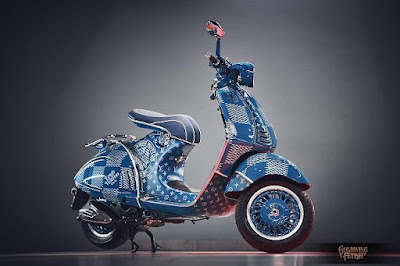Rare ONES For us (We hope You too) to talk about the classic scooter models that were present and were born around the 1950s to the 1960s is very exciting. Because as we all know in that period, the typical two-wheeled mode of transportation is enjoying its heyday. Many scooter models were born at that time and were made by many manufacturers from all over the world. Some of these companies come from British, and one of them is DKR which we will discuss today.
 |
| DKR line-up (Capella, Defiant, Dove, Manx and Pegasus scooter models) on display at the 2017 Vintage Motor Scooter Club’s Annual Extravaganza held in Coventry, West Midlands, England. (Picture from: https://bit.ly/3nMGq9m) |
For a moment, if we look physically at the scooters made in UK, they have a slightly different appearance from scooters from other countries, such as Italy, France and Germany.
 |
| The first scooter made by DKR Ltd. in 1957 is DKR Dove featured with a Villers 30C 147cc, 6.3hp engine coupled with the 3-speed manual gearbox. (Picture from: http://bit.ly/3qtYwP5) |
The average difference in appearance is seen in the front-ends, for example the appearance of the DKR scooters that were born since the 1950s to an early of the 1960s has a distinctive appearance with the the large-sized front-ends, making it look like a large nose.
DKR scooters were produced in Wolverhampton from 1957 to 1966. And the DKR Ltd. Co. was founded in 1957 by Barry Day and Noah Robinson, who were directors of the Willenhall Motor Radiator Co, and industrialist Cyril Kieft who also built racing cars. The company was run from premises at Pendeford Airport.
 |
| This is DKR Pegasus featured with a 148cc single-cylinder Villiers engine coupled with a Siba Dynastart electric starter, which ensures first-time starts, a four-speed gearbox and a Villiers carburetor. (Picture from: http://bit.ly/3oSvDvC) |
Before continuing, does anyone know, what is the stands for DKR?
During the production period the company is known has five different models, ie the Dove, the Defiant, Pegasus, Manx, and Capellawhich were built and produced consecutively starting in 1957. As you've seen on the Dove, Defiant, and Manx models appeared with their front end shaped like a large nose, and some parties said those are it's just like a distinctive style and far from what could be described as "modern".
 |
| This is DKR Defiant featured with a 197cc single-cylinder air-cooled Villiers engine coupled with a Siba Dynastart electric starter, which ensures first-time starts, a four-speed gearbox and a Villiers carburetor. (Picture from: http://bit.ly/3oSvDvC) |
 |
| This is DKR Manx featured with a 249cc two-cylinders air-cooled Villiers engine coupled with a Siba Dynastart electric starter, which ensures first-time starts, a four-speed gearbox and a Villiers carburetor. (Picture from: http://bit.ly/3oSvDvC) |
Both models have a Siba Dynastart electric starter, which ensures first-time starts, a four-speed gearbox and a Villiers carburetor. And for its performance, the engine is able to deliver it at a top speed of 60mph and gasoline consumption of 90 mpg at 30mph.
At that time the DKR Defiant model was selling for £189.15s.5d and the Pegasus was selling for £177.11s.11d.
 |
| This is DKR Capella started in the 1960 and featured with a 148cc single-cylinder Villiers engine which had revamped styling and bodywork. (Picture from: http://bit.ly/3nUaOyP) |
The DKR Manx was the next model produced starting in 1959. The scooter used a Villers two-cylinders 249cc two-stroke engine coupled with pretty much the same "distinct" body. In the 1960, the market saw the 148cc Dove II and the Pegasus II with new 174cc 2L engine.
Finally, after displaying a body style that could be said to be very monotonous on previous scooter models, it looks like this British company has been woke up and made a redemption by showing something completely new to the DKR Capella models that came out in the 1960s.
Finally, after displaying a body style that could be said to be very monotonous on previous scooter models, it looks like this British company has been woke up and made a redemption by showing something completely new to the DKR Capella models that came out in the 1960s.
The new Capella range, which had revamped styling and bodywork. It uses the three Villiers engine types, ie the 148cc 31C only for the Capella Mk 1, while the 174cc 2L only for the Standard version and the 197cc 9E plus electric starter is offered for the De Luxe versions. At the time, the Capella Standard sold for £152.13s.6d. For the De Luxe models, the 173cc version was priced at £166.10s.10d. and the 200cc version was priced at £173.13s.10d. These models continued for the next five years.
After operating for about 9 years since the company was founded in 1957, finally this company had to cease all production activities in 1966 after being unable to compete with other scooter products in the global automotive market.😢
That's
it, and if the article above is still considered inadequate or
inaccurate, or if you have additional information related to these DKR's unique-shaped scooters, please don't hesitate to let us
know via
the comments column below this article.
Kept
spur your adrenaline on the power of the two-wheeled monster and stay
alive with true safety riding. May God will forgive Your sins and so
does the cops...... *** [EKA | FROM VARIOUS SOURCES | PARKAAVENUE | GRACESGUIDE | CYBERMOTORCYCLE | SCUDERIAVESPASVEDESE ]
Note: This blog can be accessed via your smart phone.
Note: This blog can be accessed via your smart phone.

































